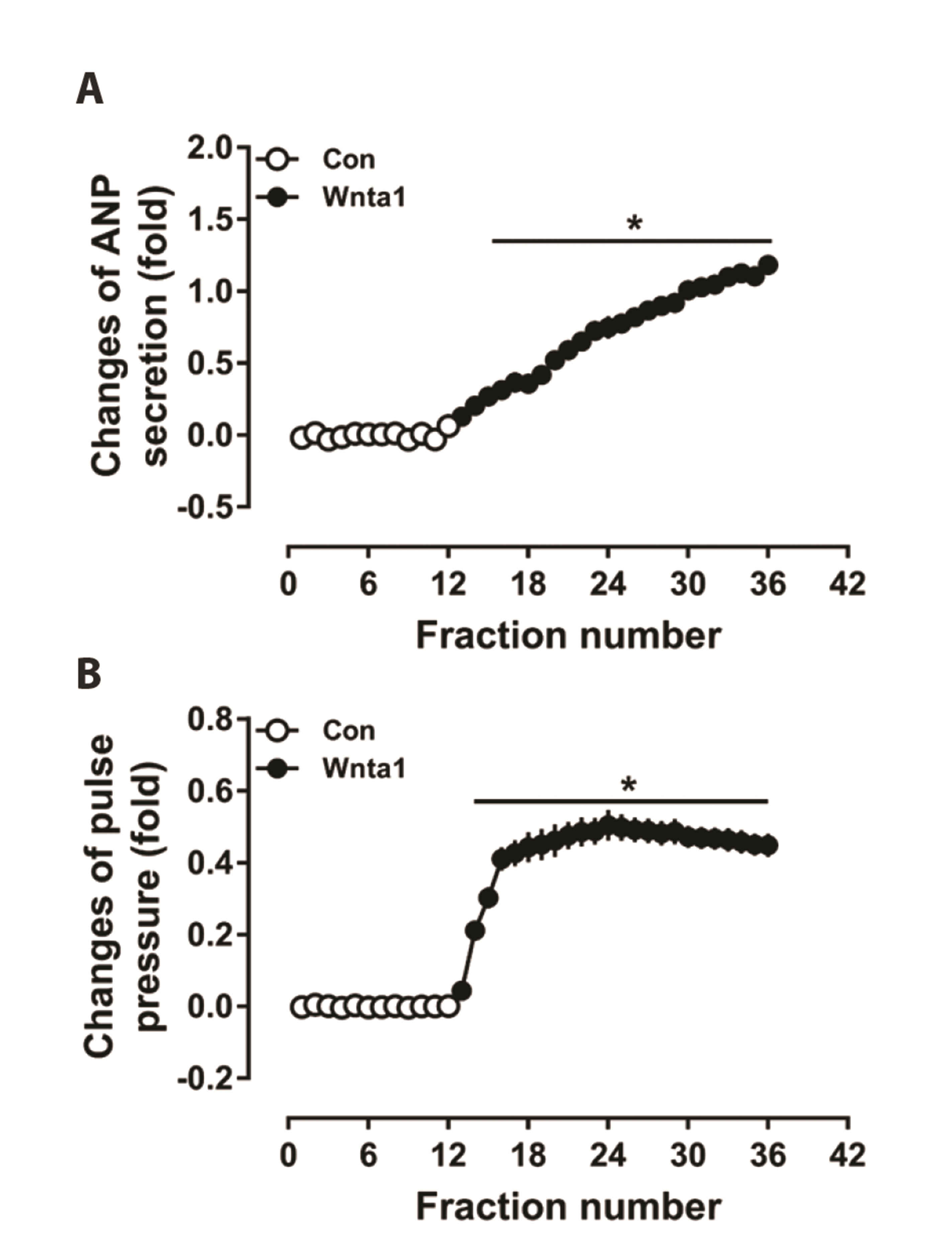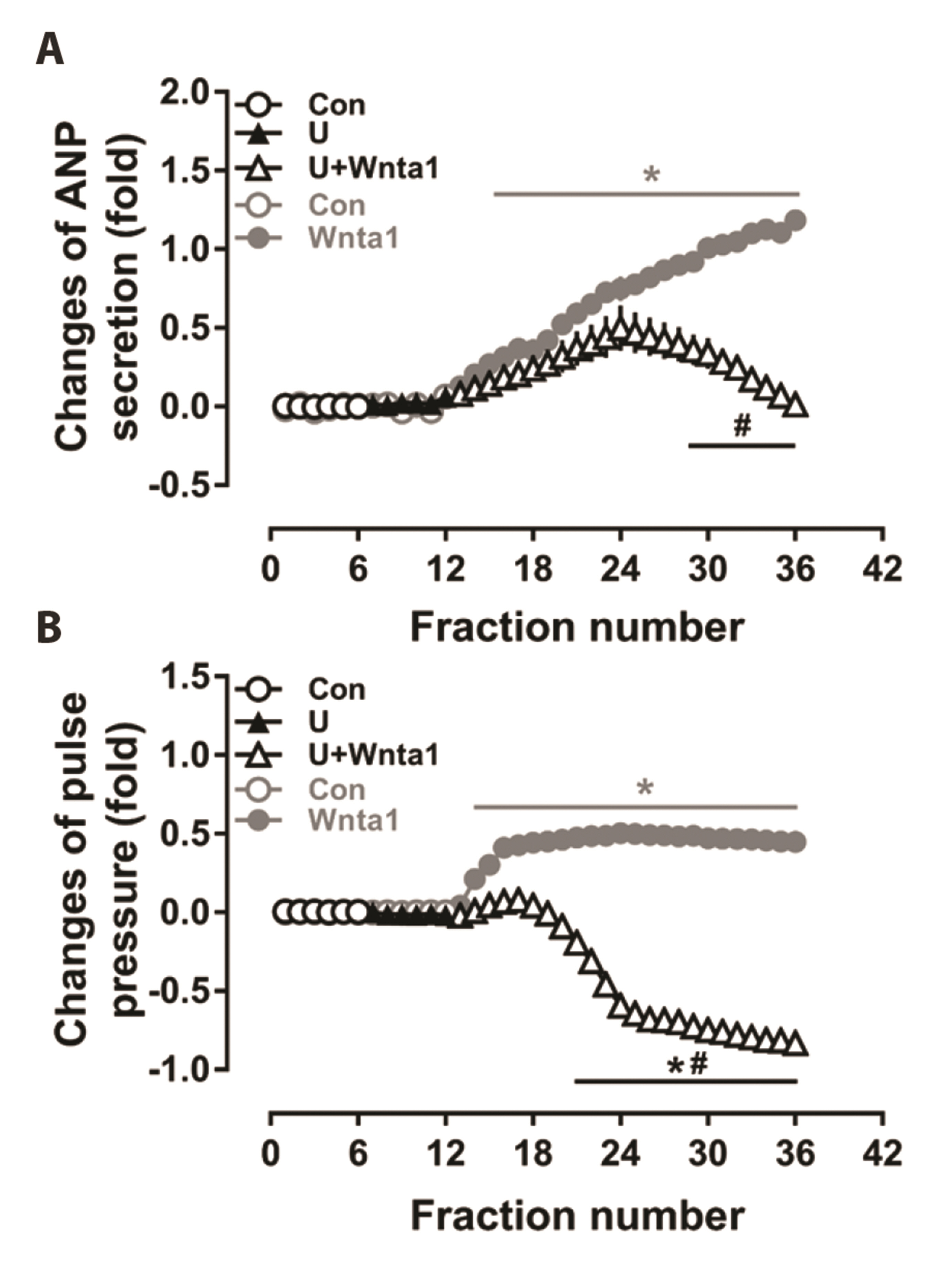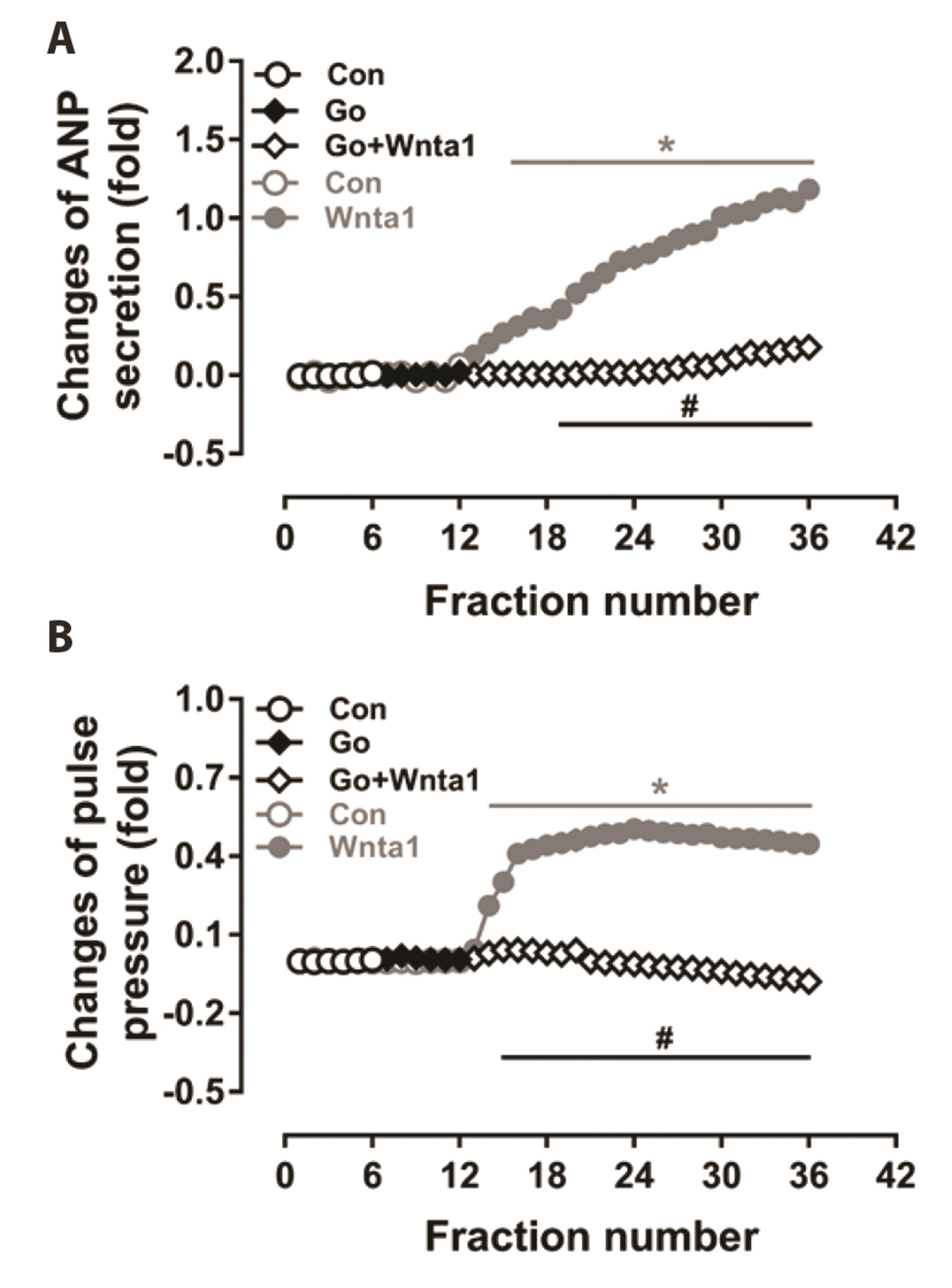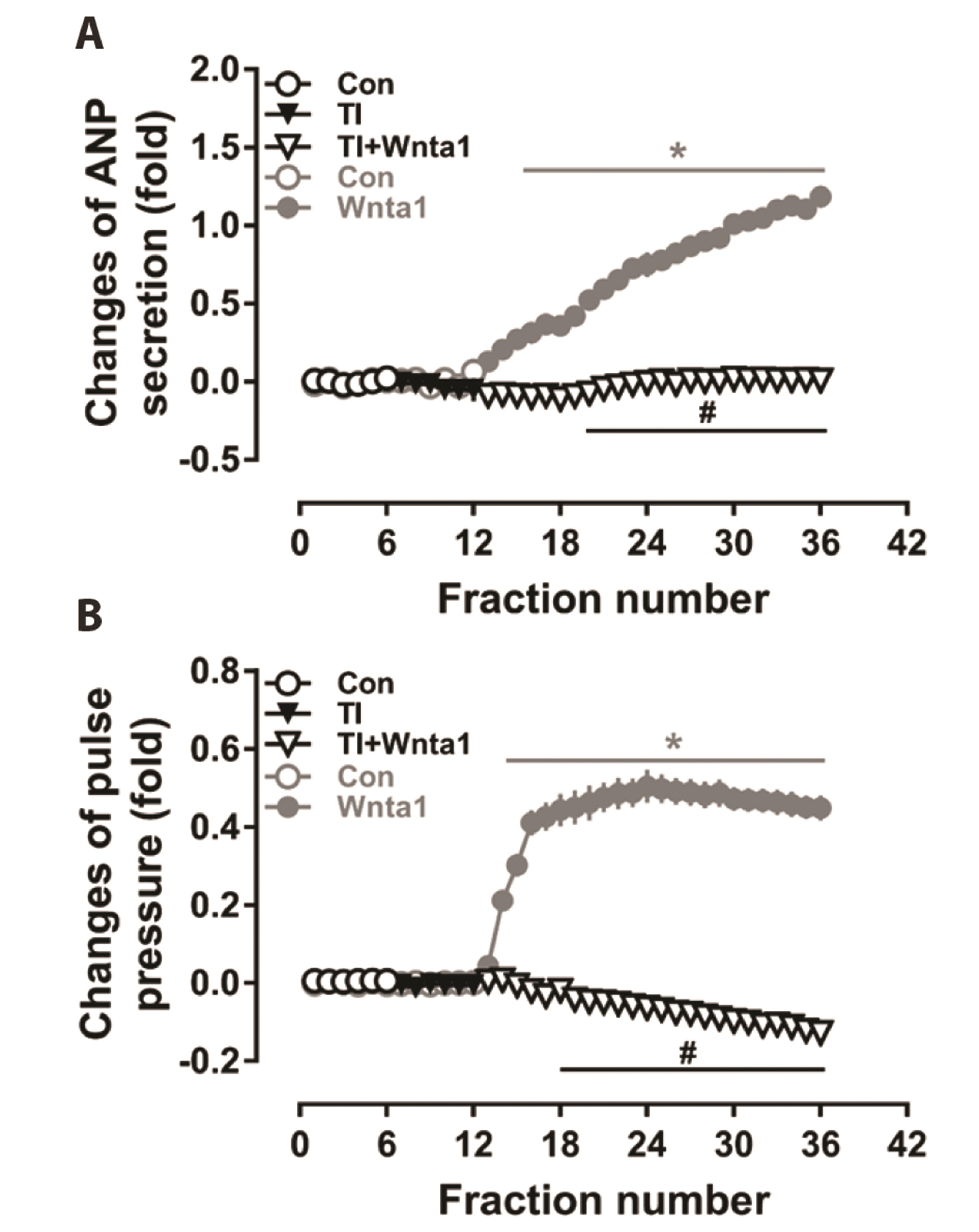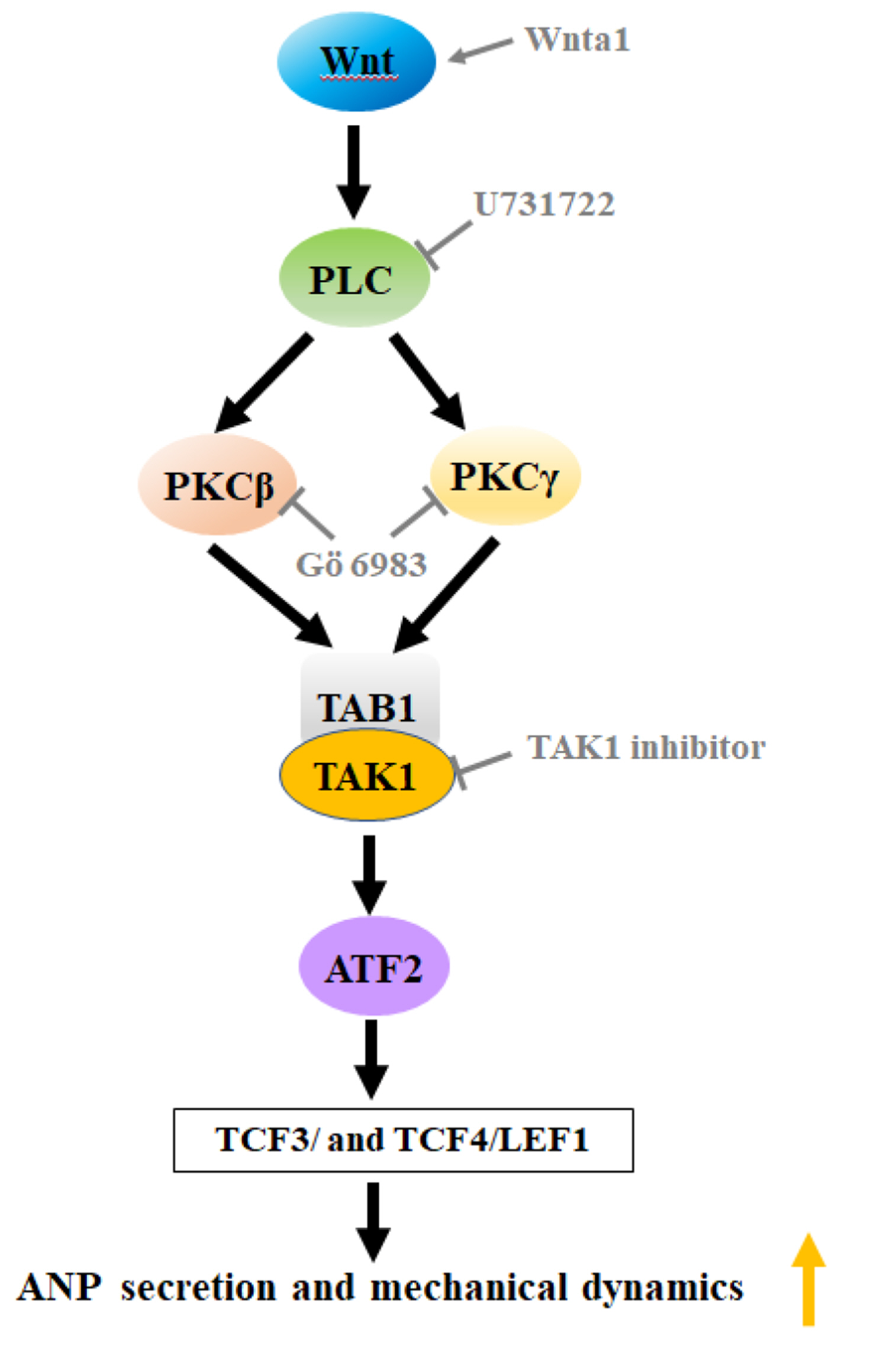Korean J Physiol Pharmacol.
2022 Nov;26(6):469-478. 10.4196/kjpp.2022.26.6.469.
The WNT/Ca2+ pathway promotes atrial natriuretic peptide secretion by activating protein kinase C/transforming growth factor-β activated kinase 1/activating transcription factor 2 signaling in isolated beating rat atria
- Affiliations
-
- 1Department of Physiology, School of Medicine, Yanbian University, Yanji 133-002, China
- 2Institue of Clinical Medicine, Yanbian University, 3 Cellular Function Research Center, Yanbian University, Yanji 133-002, China
- KMID: 2534523
- DOI: http://doi.org/10.4196/kjpp.2022.26.6.469
Abstract
- WNT signaling plays an important role in cardiac development, but abnormal activity is often associated with cardiac hypertrophy, myocardial infarction, remodeling, and heart failure. The effect of WNT signaling on regulation of atrial natriuretic peptide (ANP) secretion is unclear. Therefore, the purpose of this study was to investigate the effect of Wnt agonist 1 (Wnta1) on ANP secretion and mechanical dynamics in beating rat atria. Wnta1 treatment significantly increased atrial ANP secretion and pulse pressure; these effects were blocked by U73122, an antagonist of phospholipase C. U73122 also abolished the effects of Wnta1-mediated upregulation of protein kinase C (PKC) β and γ expression, and the PKC antagonist Go 6983 eliminated Wnta1-induced secretion of ANP. In addition, Wnta1 upregulated levels of phospho-transforming growth factor-β activated kinase 1 (p-TAK1), TAK1 banding 1 (TAB1) and phospho-activating transcription factor 2 (p-ATF2); these effects were blocked by both U73122 and Go 6983. Wnta1-induced ATF2 was abrogated by inhibition of TAK1. Furthermore, Wnta1 upregulated the expression of T cell factor (TCF) 3, TCF4, and lymphoid enhancer factor 1 (LEF1), and these effects were blocked by U73122 and Go 6983. Tak1 inhibition abolished the Wnta1-induced expression of TCF3, TCF4, and LEF1 and Wnta1-mediated ANP secretion and changes in mechanical dynamics. These results suggest that Wnta1 increased the secretion of ANP and mechanical dynamics in beating rat atria by activation of PKC–TAK1–ATF2–TCF3/LEF1 and TCF4/LEF1 signaling mainly via the WNT/Ca2+ pathway. It is also suggested that WNT–ANP signaling is implicated in cardiac physiology and pathophysiology.
Keyword
Figure
Reference
-
1. Kim HY, Cho KW, Xu DY, Kang DG, Lee HS. 2013; Endogenous ACh tonically stimulates ANP secretion in rat atria. Am J Physiol Heart Circ Physiol. 305:H1050–H1056. DOI: 10.1152/ajpheart.00469.2013. PMID: 23913708. PMID: https://www.scopus.com/inward/record.uri?partnerID=HzOxMe3b&scp=84884938581&origin=inward.
Article2. Kiemer AK, Vollmar AM. 2001; The atrial natriuretic peptide regulates the production of inflammatory mediators in macrophages. Ann Rheum Dis. 60(Suppl 3):iii68–iii70. DOI: 10.1136/ard.60.90003.iii68. PMID: 11890659. PMCID: PMC1766678.3. De Vito P, Incerpi S, Pedersen JZ, Luly P. 2010; Atrial natriuretic peptide and oxidative stress. Peptides. 31:1412–1419. DOI: 10.1016/j.peptides.2010.04.001. PMID: 20385186. PMID: https://www.scopus.com/inward/record.uri?partnerID=HzOxMe3b&scp=77953124862&origin=inward.
Article4. Hong L, Xi J, Zhang Y, Tian W, Xu J, Cui X, Xu Z. 2012; Atrial natriuretic peptide prevents the mitochondrial permeability transition pore opening by inactivating glycogen synthase kinase 3β via PKG and PI3K in cardiac H9c2 cells. Eur J Pharmacol. 695:13–19. DOI: 10.1016/j.ejphar.2012.07.053. PMID: 22975711. PMID: https://www.scopus.com/inward/record.uri?partnerID=HzOxMe3b&scp=84867571658&origin=inward.
Article5. Lugnier C, Meyer A, Charloux A, Andrès E, Gény B, Talha S. 2019; The endocrine function of the heart: physiology and involvements of natriuretic peptides and cyclic nucleotide phosphodiesterases in heart failure. J Clin Med. 8:1746. DOI: 10.3390/jcm8101746. PMID: 31640161. PMCID: PMC6832599. PMID: https://www.scopus.com/inward/record.uri?partnerID=HzOxMe3b&scp=85083845505&origin=inward.
Article6. Mezzasoma L, Peirce MJ, Minelli A, Bellezza I. 2017; Natriuretic peptides: the case of prostate cancer. Molecules. 22:1680. DOI: 10.3390/molecules22101680. PMID: 28994721. PMCID: PMC6151559. PMID: https://www.scopus.com/inward/record.uri?partnerID=HzOxMe3b&scp=85032930690&origin=inward.
Article7. Serafino A, Pierimarchi P. 2014; Atrial natriuretic peptide: a magic bullet for cancer therapy targeting Wnt signaling and cellular pH regulators. Curr Med Chem. 21:2401–2409. DOI: 10.2174/0929867321666140205140152. PMID: 24524761. PMCID: PMC4063317. PMID: https://www.scopus.com/inward/record.uri?partnerID=HzOxMe3b&scp=84901939934&origin=inward.
Article8. Zhang J, Zhao Z, Wang J. 2014; Natriuretic peptide receptor A as a novel target for cancer. World J Surg Oncol. 12:174. DOI: 10.1186/1477-7819-12-174. PMID: 24894887. PMCID: PMC4049422. PMID: https://www.scopus.com/inward/record.uri?partnerID=HzOxMe3b&scp=84901981985&origin=inward.
Article9. Foulquier S, Daskalopoulos EP, Lluri G, Hermans KCM, Deb A, Blankesteijn WM. 2018; WNT signaling in cardiac and vascular disease. Pharmacol Rev. 70:68–141. DOI: 10.1124/pr.117.013896. PMID: 29247129. PMCID: PMC6040091. PMID: https://www.scopus.com/inward/record.uri?partnerID=HzOxMe3b&scp=85040003896&origin=inward.
Article10. Moon RT, Kohn AD, De Ferrari GV, Kaykas A. 2004; WNT and beta-catenin signalling: diseases and therapies. Nat Rev Genet. 5:691–701. DOI: 10.1038/nrg1427. PMID: 15372092. PMID: https://www.scopus.com/inward/record.uri?partnerID=HzOxMe3b&scp=4344584730&origin=inward.11. Ng LF, Kaur P, Bunnag N, Suresh J, Sung ICH, Tan QH, Gruber J, Tolwinski NS. 2019; WNT signaling in disease. Cells. 8:826. DOI: 10.3390/cells8080826. PMID: 31382613. PMCID: PMC6721652. PMID: https://www.scopus.com/inward/record.uri?partnerID=HzOxMe3b&scp=85074564426&origin=inward.
Article12. Hu HH, Cao G, Wu XQ, Vaziri ND, Zhao YY. 2020; Wnt signaling pathway in aging-related tissue fibrosis and therapies. Ageing Res Rev. 60:101063. DOI: 10.1016/j.arr.2020.101063. PMID: 32272170. PMID: https://www.scopus.com/inward/record.uri?partnerID=HzOxMe3b&scp=85083282776&origin=inward.
Article13. Fu WB, Wang WE, Zeng CY. 2019; Wnt signaling pathways in myocardial infarction and the therapeutic effects of Wnt pathway inhibitors. Acta Pharmacol Sin. 40:9–12. DOI: 10.1038/s41401-018-0060-4. PMID: 30002488. PMCID: PMC6318317. PMID: https://www.scopus.com/inward/record.uri?partnerID=HzOxMe3b&scp=85049790426&origin=inward.
Article14. Stylianidis V, Hermans KCM, Blankesteijn WM. 2017; Wnt signaling in cardiac remodeling and heart failure. Handb Exp Pharmacol. 243:371–393. DOI: 10.1007/164_2016_56. PMID: 27838851. PMID: https://www.scopus.com/inward/record.uri?partnerID=HzOxMe3b&scp=85020690054&origin=inward.
Article15. Katoh M. 2018; Multi-layered prevention and treatment of chronic inflammation, organ fibrosis and cancer associated with canonical WNT/β-catenin signaling activation (Review). Int J Mol Med. 42:713–725. DOI: 10.3892/ijmm.2018.3689. PMID: 29786110. PMCID: PMC6034925. PMID: https://www.scopus.com/inward/record.uri?partnerID=HzOxMe3b&scp=85055010694&origin=inward.
Article16. Zhang CG, Jia ZQ, Li BH, Zhang H, Liu YN, Chen P, Ma KT, Zhou CY. 2009; Beta-catenin/TCF/LEF1 can directly regulate phenylephrine-induced cell hypertrophy and Anf transcription in cardiomyocytes. Biochem Biophys Res Commun. 390:258–262. DOI: 10.1016/j.bbrc.2009.09.101. PMID: 19799869. PMID: https://www.scopus.com/inward/record.uri?partnerID=HzOxMe3b&scp=70350125871&origin=inward.
Article17. Zhang B, Cui X, Jin HH, Hong L, Liu X, Li X, Zhang QG, Liu LP. 2017; Ginsenoside Re prevents angiotensin II-induced gap-junction remodeling by activation of PPARγ in isolated beating rat atria. Life Sci. 190:36–45. DOI: 10.1016/j.lfs.2017.09.027. PMID: 28962867. PMID: https://www.scopus.com/inward/record.uri?partnerID=HzOxMe3b&scp=85030156838&origin=inward.
Article18. Liu LP, Hong L, Yu L, Li HY, Ding DZ, Jin SJ, Cui X. 2012; Ouabain stimulates atrial natriuretic peptide secretion via the endothelin-1/ET(B) receptor-mediated pathway in beating rabbit atria. Life Sci. 90:793–798. DOI: 10.1016/j.lfs.2012.04.008. PMID: 22521291. PMID: https://www.scopus.com/inward/record.uri?partnerID=HzOxMe3b&scp=84860716459&origin=inward.
Article19. Lim JY, Park SJ, Hwang HY, Park EJ, Nam JH, Kim J, Park SI. 2005; TGF-beta1 induces cardiac hypertrophic responses via PKC-dependent ATF-2 activation. J Mol Cell Cardiol. 39:627–636. DOI: 10.1016/j.yjmcc.2005.06.016. PMID: 16125722. PMID: https://www.scopus.com/inward/record.uri?partnerID=HzOxMe3b&scp=24944542831&origin=inward.
Article20. Zhang M, Hagenmueller M, Riffel JH, Kreusser MM, Bernhold E, Fan J, Katus HA, Backs J, Hardt SE. 2015; Calcium/calmodulin-dependent protein kinase II couples Wnt signaling with histone deacetylase 4 and mediates dishevelled-induced cardiomyopathy. Hypertension. 65:335–344. DOI: 10.1161/HYPERTENSIONAHA.114.04467. PMID: 25489064. PMID: https://www.scopus.com/inward/record.uri?partnerID=HzOxMe3b&scp=84921539288&origin=inward.
Article21. Bae IS, Kim SH. 2019; Expression and secretion of an atrial natriuretic peptide in beige-like 3T3-L1 adipocytes. Int J Mol Sci. 20:6128. DOI: 10.3390/ijms20246128. PMID: 31817347. PMCID: PMC6940835. PMID: https://www.scopus.com/inward/record.uri?partnerID=HzOxMe3b&scp=85076305798&origin=inward.
Article22. Liu X, Zhang Y, Hong L, Han CJ, Zhang B, Zhou S, Wu CZ, Liu LP, Cui X. 2017; Gallic acid increases atrial natriuretic peptide secretion and mechanical dynamics through activation of PKC. Life Sci. 181:45–52. DOI: 10.1016/j.lfs.2017.05.024. PMID: 28535942. PMID: https://www.scopus.com/inward/record.uri?partnerID=HzOxMe3b&scp=85020054586&origin=inward.
Article23. Mukhopadhyay H, Lee NY. 2020; Multifaceted roles of TAK1 signaling in cancer. Oncogene. 39:1402–1413. DOI: 10.1038/s41388-019-1088-8. PMID: 31695153. PMCID: PMC7023988. PMID: https://www.scopus.com/inward/record.uri?partnerID=HzOxMe3b&scp=85074801913&origin=inward.
Article24. Shibuya H, Yamaguchi K, Shirakabe K, Tonegawa A, Gotoh Y, Ueno N, Irie K, Nishida E, Matsumoto K. 1996; TAB1: an activator of the TAK1 MAPKKK in TGF-beta signal transduction. Science. 24:1179–1182. DOI: 10.1126/science.272.5265.1179. PMID: 8638164. PMID: https://www.scopus.com/inward/record.uri?partnerID=HzOxMe3b&scp=0029940355&origin=inward.25. Shintani Y, Drexler HC, Kioka H, Terracciano CM, Coppen SR, Imamura H, Akao M, Nakai J, Wheeler AP, Higo S, Nakayama H, Takashima S, Yashiro K, Suzuki K. 2014; Toll-like receptor 9 protects non-immune cells from stress by modulating mitochondrial ATP synthesis through the inhibition of SERCA2. EMBO Rep. 15:438–445. DOI: 10.1002/embr.201337945. PMID: 24610369. PMCID: PMC3989675. PMID: https://www.scopus.com/inward/record.uri?partnerID=HzOxMe3b&scp=84898605890&origin=inward.
Article26. Shintani Y, Kapoor A, Kaneko M, Smolenski RT, D'Acquisto F, Coppen SR, Harada-Shoji N, Lee HJ, Thiemermann C, Takashima S, Yashiro K, Suzuki K. 2013; TLR9 mediates cellular protection by modulating energy metabolism in cardiomyocytes and neurons. Proc Natl Acad Sci U S A. 110:5109–5114. DOI: 10.1073/pnas.1219243110. PMID: 23479602. PMCID: PMC3612600. PMID: https://www.scopus.com/inward/record.uri?partnerID=HzOxMe3b&scp=84875518435&origin=inward.
Article27. McCarthy CG, Wenceslau CF, Ogbi S, Szasz T, Webb RC. 2018; Toll-like receptor 9-dependent AMPKα activation occurs via TAK1 and contributes to RhoA/ROCK signaling and actin polymerization in vascular smooth muscle cells. J Pharmacol Exp Ther. 365:60–71. DOI: 10.1124/jpet.117.245746. PMID: 29348267. PMCID: PMC5830639. PMID: https://www.scopus.com/inward/record.uri?partnerID=HzOxMe3b&scp=85043282975&origin=inward.
Article28. Grumolato L, Liu G, Haremaki T, Mungamuri SK, Mong P, Akiri G, Lopez-Bergami P, Arita A, Anouar Y, Mlodzik M, Ronai ZA, Brody J, Weinstein DC, Aaronson SA. 2013; β-Catenin-independent activation of TCF1/LEF1 in human hematopoietic tumor cells through interaction with ATF2 transcription factors. PLoS Genet. 9:e1003603. DOI: 10.1371/journal.pgen.1003603. PMID: 23966864. PMCID: PMC3744423. PMID: https://www.scopus.com/inward/record.uri?partnerID=HzOxMe3b&scp=84884631810&origin=inward.
Article
- Full Text Links
- Actions
-
Cited
- CITED
-
- Close
- Share
- Similar articles
-
- Peroxisome proliferator-activated receptor γ is essential for secretion of ANP induced by prostaglandin D₂ in the beating rat atrium
- NOX4/Src regulates ANP secretion through activating ERK1/2 and Akt/GATA4 signaling in beating rat hypoxic atria
- Insulin-Like Growth Factor 1 Actions in Developing Brain and the Interaction with Wnt Pathway
- Comparative effects of angiotensin II and angiotensin-(4-8) on blood pressure and ANP secretion in rats
- Carbon monoxide releasing molecule-2 suppresses stretchactivated atrial natriuretic peptide secretion by activating largeconductance calcium-activated potassium channels

